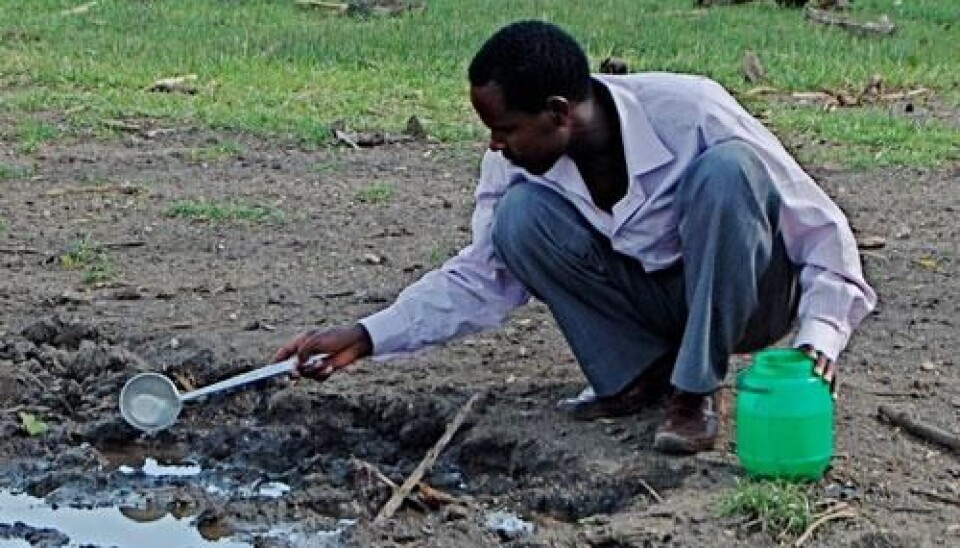This article was produced and financed by Diku - The Norwegian Agency for International Cooperation and Quality Enhancement in Higher Education

Forecasting Malaria
A new model for forecasting malaria epidemics is developed by researchers from Ethiopia and Norway.
Denne artikkelen er over ti år gammel og kan inneholde utdatert informasjon.
Climate change is presenting major challenges in Africa.
Malaria, one of the big killers of African children, is a disease directly linked to temperature and rainfall.
In Ethiopia, malaria occurs seasonally. Every four to six years there are huge epidemics, affecting as many as several hundred thousand people.
Global warming now seems to be changing the pattern of malaria. Will high-land Ethiopia experience more malaria in the future?

And if so, will it be possible to predict epidemics in time for people to prepare?
The researchers in the project "Ethiopian Malaria Prediction System" (EMAPS) set out to find out.
Increased warning time
The initial idea was that by being able to forecast weather, it would also be possible to forecast malaria.
Over a five-year period - from 2007 to 2011, they combined malaria transmission information with climate and land use variability data to develop and validate a model for predicting malaria transmission and set up an early warning system.
With the new model, the warning time could be increased from a couple of weeks to one to two months.
"The model has been developed and is ready to be published, although it needs further testing," says Bernt Lindtjørn, professor at the Centre for International Health at the University of Bergen (UiB).
He is the Norwegian coordinator of EMAPS, a collaborative effort between UiB and four Ethiopian institutions. The project is funded by Norad through The Norwegian Programme for Development, Research and Education (NUFU).
Dependent on weather patterns
According to the World Health Organization, malaria caused an estimated 655,000 deaths in 2010, mostly among African children.
Ethiopian EMAPS coordinator, Dr. Wakgari Deressa, works at the School of Public Health at Addis Ababa University. According to him, the number of people dying from malaria in Ethiopia every year is estimated to be between 70,000 and 100,000, although there are considerable variations from year to year.
"Over the last five years, there has been a decline in the malaria prevalence in Ethiopia, as in several other African countries,” he says. “This is a result of the introduction of new drugs, as well as a massive scale-up in the use of insecticide treated nets.”
PhD-candidate Adugna Woyessa worked with malaria control at the Ethiopian Ministry of Health and did a Master's degree on highland malaria before he joined EMAPS.
He says the malaria situation in Ethiopia is unstable. But if the climate is understood, it is possible to predict future epidemics.
The higher up in the Ethiopian mountain range, the less malaria there is. Millions of Ethiopians live in the highlands. As temperature is creeping up, so is the mosquito.
"Malaria is known to occur below 2,000 metres above sea level. This project has revealed malaria transmission to children living at 2,200 metres above sea level, outside national epidemic periods,” says Woyessa.
Occurrence of malaria in Ethiopia is now decreasing. This, of course, is positive, but might also lead to challenges.
He says the disease may again erupt because people are loosing their immunity. People must use their insecticide treated mosquito nets distributed by the authorities to avoid infection.
A multidisciplinary effort
For years, people have been trying to predict malaria. To succeed, Lindtjørn saw the need to link people working with water and weather patterns with the people on the health side.
A team consisting of researchers from four main disciplines was put together.
The meteorologists study the weather or climate side and hydrologists look at the water side of things. More specifically, they examine water available on the surface of the earth, since the mosquito eggs are dependant on water and adequate temperature to develop. The entomologists study the mosquitos, and the epidemiologists look at the disease malaria.
"We've managed to combine these disciplines through our modelling efforts. Everyone contributed data to the mathematical model,” adds Lindtjørn.
The first step, of course, was gathering data.
Lindtjorn says there was a significant lack of climate data for Ethiopia. They now have a large database on weather patterns and the water flow systems.
The researchers looked at health aspects, and they also collected data on how the mosquito behaves and how it affects humans in the local communities.
Involving the authorities
Bernt Lindtjorn gives us an example of how they're bridging data from different disciplines into predictions.
"One PhD-student from the Ethiopian National Meteorology Agency was able to provide 30 years of detailed data on rainfall and temperature patterns; a unique set of data. Then we had a health PhD-student who looked ten years back at the malaria patterns in Southern Ethiopia. We then merged these two sets of data asking: Could we have predicted anything?”
The answer is yes.
Lintjørn says the model seems to be working well. However, to make it applicable in different regions and under different circumstances, they need to do further testing.
He adds the importance of involving Ethiopian authorities, more specifically the ministry responsible for weather forecasting, as well as the Ministry of Health. The project has also revealed several knowledge gaps that need to be dealt with.
They have for instance experienced that seasonal weather forecasting is exceedingly difficult.
“Ethiopia needs more PhD-candidates in this area, not just for malaria forecasting, but for a number of other fields as well,” concludes Lindtjørn.
































